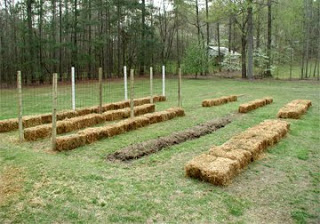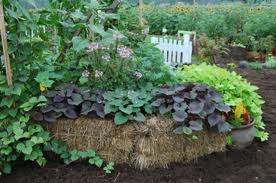Straw Bale Gardening: Strawbale Container Gardening

Straw bale gardening is container gardening where you use a bale of straw as the container and the` source of nutrients for your plants. Linda Chalker-Scott, a critical judge of urban gardening trends chronicles the history beginning with commercial growers who used this method in the 1950's and 1960's. She also reports that it was common in Eastern Europe and it also is useful in the Middle East, which has high saline and alkaline counts in its soil.
Ms. Chalker- Scott cannot explain why the widespread practice disappeared but Joel Karsten noticed weeds and thistles growing out of bales of straw. He began experimenting with growing crops out of the bales and was so successful that he wrote a book "Straw Bale Gardening" and sparked renewed interest in this type of container farming.
Materials
You need a bale of compressed organic material and although some say a bale of hay is usable, straw is preferable. The main difference between straw and hay is that hay is full of grain and seeds that may sprout and straw is the stalk of the plant whose grain has been harvested so it will not produce unwanted weeds.
Along with your bale of straw, you need:
- Water
- Fertilizer
- Sunshine
- Potting soil
- Seeds
With so few equipment needs, straw bale gardening is a relatively easy and inexpensive way to begin container gardening.
Straw Bale Process

Before you start, the outside of the bale should be dry and a little crusty and you leave the strings holding the bale together in tact, so that it maintains its container shape for the growing season. Eager gardeners who do not stimulate the composting of the bale will end up with simply a bale of straw as a container. You need to begin preparing the center of the bale two weeks before you want to plant your seeds.
To "condition" or prepare your bale for planting, you sprinkle nitrogen rich organic or non-organic lawn fertilizer on the bale and then use warm water to wash it into the straw. You continue this process over 12 days to two weeks, and when the bale feels warm, it is beginning to compost, and you can plant your seedlings. Sprinkle an inch or two of potting soil on the bale and plant your seeds. Water the bale as needed.
Straw Bale Gardening Advantages
Even if you have plenty of land, straw bale gardening might be a better alternative than tilling the land. Besides needing equipment, preparing the soil with traditional fertilizers is expensive, time consuming and often a never-ending battle to obtain and maintain the right acid-base balance. After the initial conditioning, the straw bale creates nutrient rich compost for your plants to grow, requiring only water. Other benefits of this method of gardening include:
- Simple construction - You also do not have the construction of raised beds for gardening, as you set your bales at a height that is easy for you to work your garden.
- Organic compost - After the season is over, you have nutrient rich compost that you add to your potted plants, give or sell to your friends or spread on your soil that currently is not an optimal garden site.
- Inexpensive - A bale of straw generally costs well under $10, and its a rich growing medium that offers fresh, nutritious and flavorful vegetables in concrete or poor soil environments (which is priceless).
- Accessibility - People with mobility challenges or who cannot do the weeding or tilling can garden through this method. If you have back pain or limited mobility, harvesting your root vegetables is as simple as turning the bale upside down and picking up your produce.
Straw bale gardening is a good method of growing quality vegetables with a minimal amount of time and effort, which might be an advantage when you are setting up your survival homestead. Certainly for short-term food shortages or to ensure good food at the present, this type of gardening is a good alternative for city dwellers as well as anyone who has limited time for gardening.
Return from Straw Bale Gardening to Backyard Farming





New! Comments
Have your say about what you just read! Leave me a comment in the box below.